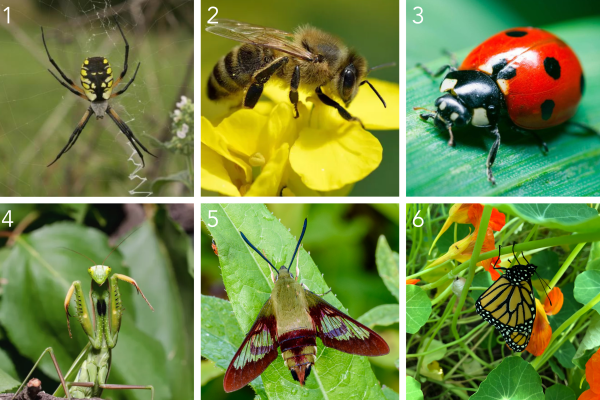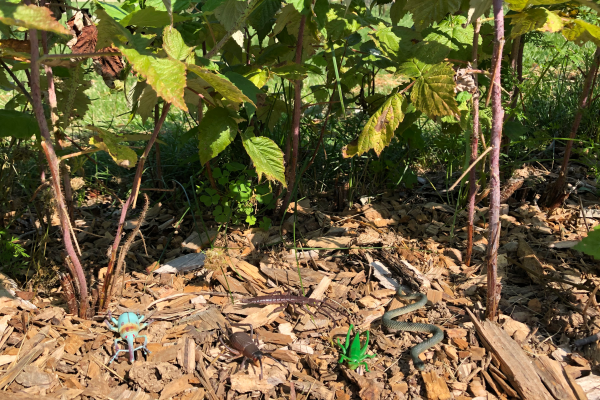Don't want hummingbird moth around at all!! They are the producers of tomato horn worms!! My worst garden pest!!
Garden Bugs: Friend or Foe?
Our gardens aren’t just full of tastes, colors, and smells - they are full of BUGS! Some of them are friends of the garden, and some will gobble up your plants faster than you can yell "BUGS ARE COOL!"
Garden Friends
Garden friends are bugs that generally help a farmer or gardener in one of two important ways. First, they may eat other bugs that damage the plants, naturally ridding our gardens of pests. Second, they may help pollinate the plants. Here are some examples of garden friends.
- Yellow Garden Spider - These large, beautiful spiders are very laid back and eat a lot of the bugs that harm gardens.
- All of the bees! - Think bumble bees, mason bees, honey bees. Bees transfer pollen from flower to flower as they drink the flower’s nectar. This pollen is important in fertilization and fertilization is required for many flowers to produce seeds and fruit.
- Ladybugs (aka Lady Beetles) - These iconic insects are incredible at gobbling up smaller bugs, larvae, and eggs - like aphids and the eggs of tomato hornworms.
- Praying Mantis - Mantises are another garden friend with an enormous appetite for bugs that destroy gardens like caterpillars, grasshoppers, and aphids!
- Clearwing Hummingbird Moth - Is it a bird? Is it a bee? This gorgeous moth will make you look twice! They are excellent pollinators and you have a chance of seeing one since they are active during the day unlike most moths. Phlox, beebalm, and verbena are a few of their favorite flowers to visit!
- Monarch Butterfly - You probably already know this breathtaking pollinator. As a caterpillar, it prefers to eat milkweed - not your garden plants - unless of course you plant an ornamental milkweed like the Oscar Milkweed found in our education gardens. Keep a watchful eye on milkweed for beautiful black-, white-, and yellow-striped monarch caterpillars. Then, keep an even CLOSER eye out for their beautiful green chrysalises with hints of golden flecks hanging from your milkweed or nearby plants. The chrysalises will hatch into adult monarch butterflies.
Garden Foes
Destructive insects can be frustrating in a garden, and costly to farmers growing vegetables and fruits for sale. But it’s important to remember that whether friend or foe, insects play critical roles in nearly every ecosystem. Gardens are just a certain kind of ecosystem where we really want to control the outcome! So next time you're in a garden, poke around and peek under leaves and discover what critters are sharing the plot with you!
- Tomato Hornworms - Tomato hornworm caterpillars can quickly devour the leaves and fruit of your tomato plants, and despite their size (up to 4 inches long!), they are surprisingly camouflaged against the tomato plant. I look for their large brown droppings and then follow the plant upwards until I find the hornworm and then remove it. If the hornworm is covered in small white cocoons, you can leave it as it has become host to a parasitic wasp that is beneficial to your garden! It is also believed that planting basil, dill, and marigolds alongside your tomatoes can help deter hornworms from moving in. Tomato hornworms turn into the beautiful Five Spotted Hawk Moth - a moth resembling a hummingbird with a 4-6 inch wingspan!! This moth is a pollinator as well as food for bats.
- Cabbage Looper - This small, green caterpillar moves like an inchworm and LOVES to devour any plant in the brassica family, which includes cabbage, kale, and broccoli. Remove these critters if you find them. Luckily, some of the garden friends mentioned above will eat these caterpillars! I admit that finding a benefit to these larvae and their moths was quite challenging, but the caterpillars and moths do provide food for other insects, birds, and bats. Parsley, dill, and fennel are recommended herbs to plant in your garden to attract the bugs that eat these loopers.
- Aphids - A common plant pest both indoors and out, Aphids are tiny but can reproduce exponentially! They destroy a plant by sucking out its juices, and as they feed they secrete a substance that attracts ants and fungus. Fortunately, ladybugs will happily gobble up aphids. In fact, that was about the only benefit to aphids I could find: they are important food for ladybugs (and certain other predatory insects)!
- Cucumber Beetle - This striking beetle can quickly eat through the leaves, flowers, and fruits of its favorite plants - cucumber and other squashes. To make matters worse its larvae (the female lays about 1500 eggs at a time) feasts on the plants’ roots! Michael Minchek, one of our farm educators, uses an organic castile soap, like Dr. Bronners, to help rid our education garden of these garden foes. He mixes 1 cup per gallon of water and uses a spray bottle to spray once a week in the morning. Then he reapplies after any rain.
Camo Critters Activity
Now that you've met some of these garden insects, warm up your eyes and practice your observation skills with a fun game of Camo Critters! One person places toy critters of all colors and sizes among the garden beds. Then, the others try to locate as many “hidden” critters as they can. It’s amazing what we can sometimes overlook that is right in front of our eyes!
Helpful facilitation hints: Make sure to set physical boundaries. Prepare participants to observe with only their eyes and not their hands. Ask players to keep the locations of the critters to themselves until the end of the game so all participants have a chance to observe.
Looking for a great outdoor-friendly bug ID resource? We use the Mac’s Field Guide to Northeast Garden Bugs!


